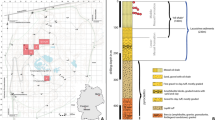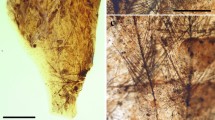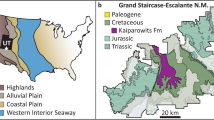Abstract
Harvestmen (Arachnida: Opiliones) are a common and widespread group, the most familiar of which are recognizable by their small, rounded bodies and long, slender legs ('daddy long-legs'). Their fossil record is generally poor, but new and exceptionally well-preserved harvestmen have been found in the famous 400-million-year-old Rhynie cherts of Scotland. These remarkable and surprisingly modern-looking fossils include male and female genital structures (a penis and ovipositor) and branching tracheal tubes — providing the oldest unequivocal evidence in any arthropod for air-breathing through the tracheae.
Similar content being viewed by others
Main
The Early Devonian (Pragian) Rhynie cherts of Aberdeenshire are an ancient hot-springs system that preserves an early terrestrial-aquatic ecosystem1. Both plant and arthropod cuticles have been preserved in three dimensions in extraordinary detail through floods of silica-rich water2. Terrestrial arthropods from Rhynie include mites, the extinct trigonotarbid arachnids, springtails and myriapods3. To this list we can now add the oldest record of harvestmen. The fossils described here were discovered in thin sections of polished chert and are deposited in the palaeobotany section of the University of Münster, Germany.
The largest harvestman (body length about 6 mm) is preserved on a slide-mounted thin section and shows a lateral section along the midline (Fig. 1a). Typically for harvestmen, the body is deep and compact in outline,with little or no tagmosis between the prosoma and opisthosoma. Many Rhynie arthropods preserve internal, cuticle-lined structures3,4.
a, Lateral midline section of a female specimen, revealing the outline of the body and internal ovipositor. b, Detail of the annulate, setose ovipositor and its membranous sheath. c, Reverse side of same slide, showing oldest unequivocal arthropod tracheae, with a large stem trachea and several secondary tracheae. d, Ventral view of male opisthosoma and posteriormost coxae, with sternites missing to reveal opisthosomal contents, including a rod-like penis. Key: ann, annulation of ovipositor; ch, chelicerae; cx, coxa; et, eye tubercle; go, genital opening; ovi, ovipositor; pen, penis; se, seta; set, secondary trachea; sh, ovipositor sheath; stt, stem trachea. Scale bars, 1 mm (a); 50 µm (b); 200 µm (c, d).
The harvestman opisthosoma contains a long, annulated feature, originating towards the back of the opisthosoma and curving gently down towards the leg bases, where it fades out of the plane of section. Comparison with living harvestmen5 reveals that this is an ovipositor. It is of a type that is unique to harvestmen and which, in living animals, is extended some distance beyond the body during egg-laying. The fossil ovipositor lies within a thin cuticular sheath and forms a tube of 300-µm diameter. Surprisingly fine detail is preserved in the ovipositor itself Fig. 1b), including its thin, deeply folded wall and several short, probably sensory, setae.
The reverse side of the same slide shows the animal at a more lateral plane of section. In the middle of the opisthosoma is a dark gut trace, and below this a series of pale, tubular structures originate from an unresolved point on the ventral surface behind the fourth leg coxa (Fig. 1c). These are clearly tracheae, because their gross morphology and position within the anterior opisthosoma are almost identical to those of living harvestmen6 and they show characteristic spiral thickenings near the bases of the tubes. A large stem trachea, of maximum diameter 170 µm, curves anteriorly into the prosoma but fades rapidly out of the plane of section; four narrower, secondary tracheae run posterolaterally towards the gut trace within the opisthosoma, further dividing into about 20 individual tubes.
A second specimen is smaller (with an opisthosoma length of about 1.2 mm) and is essentially a ventral view, in which the surface of the opisthosoma has been lost during sectioning to reveal internal structures. This specimen is associated with extremely long and slender legs, more or less in the same position as in life. Other distinctive harvestman features here include the anterior displacement of the genital opening, represented by an oval ring of cuticle nestled between the coxae of the fourth pair of legs.
A smooth, slender, rod-like median structure originates towards the back of the opisthosoma and tapers towards the genital opening. By comparison with living harvestmen7, this is evidently a penis and the male specimen preserves the oldest fossilized example of such an intromittent organ (Fig. 1d). It is extended from the body during mating and facilitates direct sperm transfer. The shaft of the penis tapers anteriorly, where there is a disjunct transition to the tip. This is formed from an ovate, swollen glans, which merges into a slender, bluntly pointed stylus. Again, details are preserved,including short setae on the glans, an apparent intromittent canal within the stylus and possible muscle tendons attaching to the glans. An almost identical morphology occurs in closely related living forms7.
The most remarkable aspect of these Rhynie chert fossils is their modernity, not only in gross morphology, but in the fine spatial and structural details of their respiratory and reproductive organs. Although tracheae have been inferred from putative spiracles in a myriapodous Devonian arthropod8, the harvestman structures described here provide the oldest unequivocal evidence for branching tracheal tubes in any arthropod so far. Together with the oldest book lungs, also from Rhynie4, these tracheae indicate that that there were fully terrestrial arachnids at this time that had modern-looking pulmonate and tracheate respiratory systems. The form of the genitalia imply that the modern harvestman reproductive behaviour of copulation, and subsequent oviposition in the substrate, was also established early in the Devonian.
In harvestman phylogeny9, four major lineages are recognized: Cyphophthalmi, Eupnoi, Dyspnoi and Laniatores. The genitalia allow us tentatively to resolve the position of these Rhynie chert fossils. An annulate ovipositor occurs only in Cyphophthalmi and Eupnoi. The relatively large size and the presence of a median eye tubercle rules out the basal clade Cyphophthalmi; the ovipositor therefore indicates that the Rhynie harvestmen are crown-group arachnids that can be referred with some confidence to the extant suborder Eupnoi. This group includes the common and familiar 'daddy long-legs' type of harvestman.
References
Rice, C. M., Trewin, N. H. & Anderson, L. I. J. Geol Soc. Lond. 159, 203–214 (2002).
Trewin, N. H. Trans. R. Soc. Edinb. Earth Sci. 84, 433–442 (1994).
Anderson, L. I. & Trewin, N. H. Palaeontology 46, 467–509 (2003).
Claridge, M. F. & Lyon, A. G. Nature 191, 1190–1191 (1961).
Martens, J., Hoheishel, U. & Götze, M. Zool. Jb. Anat. 105, 13–76 (1981).
Höfer, A. M., Perry, S. F. & Schmitz, A. Arth. Struct. Develop. 29, 13–21 (2000).
Martens, J. Ent. Germ. 3, 51–58 (1976).
Edgecombe, G. D. Nature 394, 172–175 (1998).
Giribet, G. et al. Cladistics 18, 5–70 (2002).
Author information
Authors and Affiliations
Corresponding author
Ethics declarations
Competing interests
The authors declare no competing financial interests.
Rights and permissions
About this article
Cite this article
Dunlop, J., Anderson, L., Kerp, H. et al. Preserved organs of Devonian harvestmen. Nature 425, 916 (2003). https://doi.org/10.1038/425916a
Issue Date:
DOI: https://doi.org/10.1038/425916a
This article is cited by
-
Penis morphology in a Burmese amber harvestman
The Science of Nature (2016)
-
An exquisitely preserved harvestman (Arthropoda, Arachnida, Opiliones) from the Middle Jurassic of China
Organisms Diversity & Evolution (2012)
-
Anatomically modern Carboniferous harvestmen demonstrate early cladogenesis and stasis in Opiliones
Nature Communications (2011)
-
Early Terrestrial Animals, Evolution, and Uncertainty
Evolution: Education and Outreach (2011)
-
Calibrating the chelicerate clock: a paleontological reply to Jeyaprakash and Hoy
Experimental and Applied Acarology (2009)
Comments
By submitting a comment you agree to abide by our Terms and Community Guidelines. If you find something abusive or that does not comply with our terms or guidelines please flag it as inappropriate.




